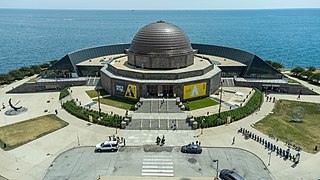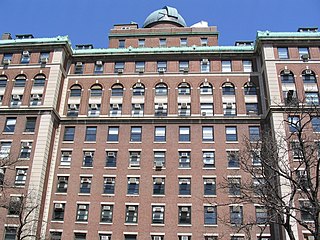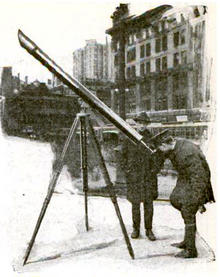
Amateur astronomy is a hobby where participants enjoy observing or imaging celestial objects in the sky using the unaided eye, binoculars, or telescopes. Even though scientific research may not be their primary goal, some amateur astronomers make contributions in doing citizen science, such as by monitoring variable stars, double stars, sunspots, or occultations of stars by the Moon or asteroids, or by discovering transient astronomical events, such as comets, galactic novae or supernovae in other galaxies.

The Adler Planetarium is a public museum in Chicago, Illinois, dedicated to astronomy and astrophysics. It was founded in 1930 by local businessman Max Adler. Located on the northeastern tip of Northerly Island on Lake Michigan, the Adler Planetarium was the first planetarium in the United States. It is part of Chicago's Museum Campus, which includes the John G. Shedd Aquarium and The Field Museum. The Planetarium's mission is to inspire exploration and understanding of the universe.

Henry Draper was an American medical doctor and amateur astronomer. He is best known today as a pioneer of astrophotography.

Norman Sperling is an author, editor, publisher, teacher, and telescope designer living in San Mateo, California.

Space Place at Carter Observatory is an observatory in Wellington, New Zealand, located at the top of the Wellington Botanic Garden.

Astronomy is a monthly American magazine about astronomy. Targeting amateur astronomers, it contains columns on sky viewing, reader-submitted astrophotographs, and articles on astronomy and astrophysics for general readers.
The Amateur Astronomers Association of Pittsburgh (AAAP) is an Astronomical Organization founded on June 9, 1929, by Chester B. Roe and Leo J. Scanlon. Since its establishment, it has grown to have over 500 members and operates two observatories in the Pittsburgh region: the Nicholas E. Wagman Observatory and the Mingo Creek Park Observatory. The club also sponsors many star parties that are open to the public throughout the year.
Rainwater Observatory and Planetarium is an educational astronomical observatory and Planetarium run as an educational ministry of French Camp Academy. It is located near French Camp, Mississippi, United States. It is the largest observatory in Mississippi with 16+ telescopes, with the largest instruments including a 32-inch Dobsonian telescope and 14-inch Celestron catadioptric telescope. Rainwater is currently awaiting delivery of the Sollee Telescope, a 25-inch research-grade telescope. When installed in the two-story observatory building already constructed in the observatory complex, the Sollee Telescope will be suitable for serious astronomical studies, in the last remaining "dark spot" in Mississippi on the U.S. Dark Skies photograph.
UNA Observatory is an astronomical observatory owned and operated by the University of North Alabama. It is located in Florence, Alabama (USA). It has 2 telescopes, a Celestron 0.35 m Schmidt–Cassegrain telescope. The UNA Planetarium is a 65-seat planetarium with a Spitz A3P projector and East Cost Control Systems controller.

The Bradley Observatory is an astronomical observatory owned and operated by Agnes Scott College. It is located in Decatur, Georgia, 5 miles (8.0 km) east of Atlanta, Georgia, (USA). The observatory's largest telescope, the Beck Telescope, is a vintage 30 inch (750 mm) Cassegrain reflector built in 1930. The mount was built by Warner & Swasey, and the optics were built by Fecker. The telescope was originally owned and operated by an amateur astronomer, Mr. Henry Gibson. He offered the telescope for sale in Popular Astronomy magazine in 1947, seeking to upgrade his own telescope. Agnes Scott purchased it in 1947 for about $15,000 after an offer from the Soviet Union was declined for reasons related to the Cold War. For many years, the Beck telescope was the largest in the Southeast United States, only superseded when the Fernbank Observatory opened in 1972 with its 36-inch (910 mm) telescope.

ʻImiloa Astronomy Center is an astronomy and culture education center located in Hilo, Hawaii. Conceived by founding Director George Jacob in 2001, it features exhibits and shows dealing with Hawaiian culture and history, astronomy, and the overlap between the two.

The Royal Observatory of Belgium has been situated in the Uccle municipality of Brussels since 1890.

Rutherfurd Observatory is the astronomical facility maintained by Columbia University named after Lewis Morris Rutherfurd. Initially, Rutherfurd housed its telescopes and equipment in midtown Manhattan and later on the Stuyvesant Estate. When the Morningside campus was built, telescopes were kept in a "transit building" where the Interdisciplinary Science Building now stands. When Pupin Physics Laboratories were completed in 1927, the home of the observatory was moved to the top of the building. Below the Rutherfurd Observatory on the 14th floor was the site of Professor Wallace Eckert's Astronomical Laboratory, in which he constructed the first device to perform general scientific calculations automatically in 1933-34.
The Escambia Amateur Astronomers Association (EAAA) is an amateur astronomy club in Northwest Florida.

Mills Observatory is the first purpose-built public astronomical observatory in the UK, located in Dundee, Scotland. Built in 1935, the observatory is classically styled in sandstone and has a distinctive 7 m dome, which houses a Victorian refracting telescope, a small planetarium, and display areas. The dome is one of two made from papier-mâché to survive in the UK, the other being at the Godlee Observatory.

The Dearborn Observatory is an astronomical observatory located on the Evanston campus of Northwestern University. The observatory was originally constructed in 1888, through an agreement between the university and the Chicago Astronomical Society. In the summer of 1939, Dearborn Observatory had to be moved to make way for the construction of the Technological Institute.

In 2011, Chile was home to 42% of the world's astronomical infrastructure, consisting principally of telescopes. In 2015, it was estimated that Chile would contain more than 50% of the global astronomical infrastructure by 2030. In the Atacama Desert region of northern Chile, the skies are exceptionally clear and dry for more than 300 days of the year. These conditions have attracted the world's scientific community to develop highly ambitious astronomical projects in the Atacama Desert.
The Von Braun Astronomical Society is a society of amateur and professional astronomers dedicated to education and public outreach on behalf of astronomy based in Huntsville, Alabama, United States.

The Linden Observatory Complex is a heritage-listed former observatory and manufacture of optical precision implements and now residence, museum, observatory, education facility and meeting venue located at 91 – 111 Glossop Road, Linden, City of Blue Mountains, New South Wales, Australia. It was designed and built by Ken Beames from 1938 to 1948. It is also known as K Beames Engineering Co. The property is owned by the Linden Observatory Trust. It was added to the New South Wales State Heritage Register on 5 March 2010.
















